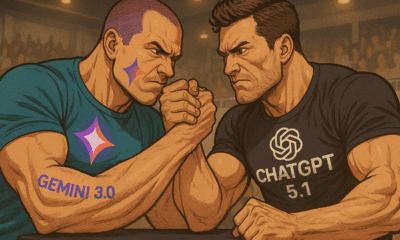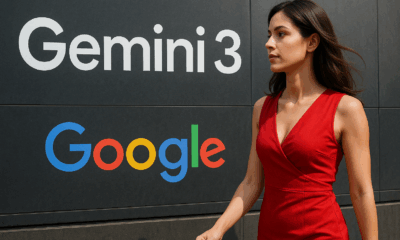News
A Shield of Code: How Booking.com Uses AI to Safeguard Your Travel Plans

- Share
- Tweet /data/web/virtuals/375883/virtual/www/domains/spaisee.com/wp-content/plugins/mvp-social-buttons/mvp-social-buttons.php on line 63
https://spaisee.com/wp-content/uploads/2025/09/booking-1000x600.png&description=A Shield of Code: How Booking.com Uses AI to Safeguard Your Travel Plans', 'pinterestShare', 'width=750,height=350'); return false;" title="Pin This Post">
When you press that final “Book Now” button on your travel itinerary, you’re doing more than locking in dates and destinations. You’re handing over sensitive personal and financial information to a platform you hope is as secure as it is seamless. At Booking.com, a titan in the online travel industry, this trust is taken seriously—and increasingly, it’s artificial intelligence that ensures it isn’t misplaced.
Siddhartha Choudhury, Senior Product Manager at Booking.com, recently spoke about the company’s multifaceted approach to battling online fraud. From complex machine learning algorithms to ethical AI practices, his insights reveal a technological chess game happening in real time—a game where the stakes are your money, your data, and your peace of mind.
The Digital Battlefield of Travel Fraud
Online travel platforms are a goldmine for fraudsters. With millions of users, thousands of properties, and constant financial transactions, Booking.com’s digital ecosystem is under continuous threat. The challenges are as vast as the platform’s reach: phishing scams that mimic Booking.com emails, stolen credit card usage, bot-generated fake reviews, account takeovers, and property listing scams.
To detect and neutralize these threats, Booking.com doesn’t rely on a single layer of protection. Instead, it operates what Choudhury describes as a hybrid model—one that combines multiple vendor-provided machine learning solutions with proprietary, in-house AI systems. This allows the company to remain agile and scalable, matching the growing sophistication of cyberattacks with equally sophisticated defenses.
AI, in this context, becomes not just a watchdog but a strategist. It helps identify anomalous patterns that could indicate fraudulent behavior—whether it’s a sudden spike in user reviews from a single IP address or an unusually high number of bookings made from a flagged email domain. The system isn’t just looking at what’s happening now; it’s using historical data, machine learning models, and behavioral analysis to predict what might happen next.
Cloud Power Meets Real-Time Intelligence
Central to this strategy is the migration to cloud infrastructure. This move has significantly expanded Booking.com’s ability to ingest, store, and analyze vast quantities of data. With petabytes of information flowing in—from backend infrastructure logs to user-generated content and customer service interactions—the cloud gives AI systems the bandwidth to detect anomalies in real time.
According to Choudhury, the speed and scale provided by cloud computing allow Booking.com to identify threats before they escalate. It also gives AI models room to evolve. “Multiple AI assistants are working in parallel for security analysts to improve their efficiency and reduce operational toil,” he explained. These assistants, far from replacing human analysts, augment their abilities. They flag potential risks, prioritize alerts, and offer insights, allowing human analysts to focus on the most critical and complex cases.
This kind of AI-assisted security model embodies what modern cybersecurity experts have long advocated: humans in the loop. The machines work tirelessly, scanning billions of data points for signs of trouble, while humans make the final call—especially when nuance, context, or ethical consideration is required.
Walking the Tightrope: Performance vs. Cost
Yet, the fight against fraud doesn’t come cheap. One of the most persistent challenges Booking.com faces is balancing security performance with operational costs. Advanced fraud detection systems, particularly those involving machine learning and cloud infrastructure, require significant investment—not only in development and deployment but also in ongoing training, monitoring, and refinement.
Choudhury is candid about the dilemma. “The decision is: should we make things more cost-efficient, or should we make it even better performance-wise?” he mused. It’s a familiar tension in the world of cybersecurity: while greater sophistication often yields better results, it also raises the financial bar, particularly at scale.
For Booking.com, which handles millions of transactions daily across the globe, the stakes are amplified. Every false positive—a legitimate user flagged incorrectly—can lead to user frustration and potential revenue loss. Every false negative—a missed fraud attempt—can cause financial and reputational damage. The AI must walk a razor’s edge, continually improving accuracy while keeping the cost-benefit ratio within acceptable bounds.
Ethics in Action: Building Responsible AI
As AI systems become more integral to security decisions, questions of transparency, fairness, and accountability grow louder. Booking.com, aware of the ethical implications, has put in place a range of safeguards to ensure its AI systems operate responsibly.
First, fairness is not just a buzzword—it’s a built-in requirement. Before deploying any fraud detection algorithm, the team runs fairness checks to ensure that the model doesn’t disproportionately impact any demographic or user group. Bias, whether intentional or incidental, can erode trust and lead to regulatory consequences, particularly in an industry as global as travel.
Human oversight remains a critical part of the system. AI might raise a red flag, but in cases of ambiguity or severity, the final decision still rests with a trained human analyst. This layered approach not only reduces the risk of algorithmic error but also builds a level of explainability into the process. Users and stakeholders alike can trace decisions back to human judgment, supported—but not dictated—by machines.
Another cornerstone is explainability. Booking.com’s AI systems are designed to offer reasons behind their actions. This transparency is vital not just for internal debugging or audits, but also for external communication. If a user is locked out of an account or a transaction is blocked, the company aims to provide a clear, logical explanation, rather than a cryptic AI-generated verdict.
And then there’s the matter of privacy. As AI systems analyze behavioral data and transaction histories, ensuring compliance with privacy laws such as GDPR is non-negotiable. Booking.com places user consent and data protection at the center of its operations, aligning technological ambitions with regulatory expectations.
The Road Ahead: Toward Intelligent Orchestration
Looking forward, Choudhury envisions a new layer of sophistication—what he calls a “security orchestration layer.” In simple terms, this would unify and coordinate various security tools across departments, ensuring they work together more efficiently and effectively.
In large organizations, security tools often proliferate across silos—each team using its own solution, tailored to its needs. But this fragmented approach can create blind spots and inefficiencies. An orchestration layer would tie these systems together, enabling faster responses, better resource allocation, and a holistic view of threats.
Such a move isn’t just about better defense. It’s about building resilience into the very fabric of the organization. In an era where threats are constant and often unpredictable, orchestrated defense systems could mean the difference between a quick recovery and a prolonged crisis.
Confidence Behind the Curtain
Ultimately, what Booking.com is building isn’t just a technological marvel—it’s a foundation of trust. Most users will never see the algorithms or know the names of the tools protecting their bookings. But they’ll feel the results. Smooth check-ins. Seamless payments. Emails they can trust. And most importantly, confidence that their information is safe in a world where digital crime never sleeps.
“AI is giving us a little more peace of mind that we won’t become victims of online fraud after clicking ‘book’ on that holiday,” Choudhury remarked. In that simple sentence lies the mission of a company—and the promise of technology done right.
Why This Matters
In the grand narrative of artificial intelligence, flashy breakthroughs often steal the spotlight—robots painting portraits, chatbots passing exams, generative models rewriting the rules of creativity. But behind the curtain of our everyday digital lives, quieter revolutions are unfolding. AI is becoming the silent guardian of our financial and personal security.
Booking.com’s approach shows that AI’s most powerful application may not be in replacing humans, but in protecting them—in building trust, ensuring fairness, and responding faster than any human team ever could. It’s a model that other industries would do well to study and emulate.
And for the rest of us, it’s a reminder that the future of travel—and the future of AI—are not just about where we’re going, but how safely we get there.
AI Model
How to Prompt Nano Banana Pro: A Guide to Creating High-Quality Images with Google’s AI

Why Nano Banana Pro Matters
Nano Banana Pro is Google DeepMind’s most advanced image generation model, built on the powerful Gemini 3 Pro architecture. It delivers high-resolution outputs (up to 4K), understands complex prompts with layered context, and performs exceptionally well when generating realistic lighting, textures, and dynamic scenes. It also supports image referencing — letting you upload photos or designs to guide the visual consistency.
In short, it’s not just a toy — it’s a tool for designers, marketers, illustrators, and creatives who want to build professional-grade images fast. But to unlock its full potential, you need to learn how to prompt it properly.
Prompting Basics: Clarity Beats Cleverness
The secret to powerful results isn’t trickery — it’s clarity. Nano Banana Pro doesn’t need keyword spam or obscure syntax. It needs you to be specific and structured.
Here are the key rules to follow:
- Be descriptive, not vague: Instead of “a cat,” write something like “a ginger British shorthair cat sitting on a marble countertop under soft morning light.
- Layer your descriptions: Include details about the subject, setting, atmosphere, materials, lighting, style, and mood.
- State your format: Tell the model if you want a photo, digital painting, cinematic frame, 3D render, infographic, comic panel, etc.
- Use reference images: Nano Banana Pro supports multiple uploads — useful for matching styles, poses, faces, characters, or branding.
This is how professionals prompt: not by hacking the system, but by being precise about what they want.
Crafting Prompts by Use Case
📸 Realistic Photography
Want a product photo, fashion portrait, or cinematic still? Then your prompt should include lens type, lighting style, subject age, composition, and color grading.
Example:
Professional studio portrait of a 35-year-old woman in natural light, soft cinematic lighting, shallow depth of field, 85mm lens look, natural skin tones, soft shadows, clean background, editorial style.
Another example:
A 3/4 view of a red sports car parked in a luxury driveway at golden hour, realistic reflections, soft shadows, DSLR-style image, bokeh background.
These prompt structures help the model replicate not just the subject but the feel of a professionally shot image.
🎨 Illustration, Comic Art, and 3D Concepts
If you want stylized work — like a retro comic, anime-style character, or matte painting — the style must be part of the prompt.
Example:
Comic-style wide cinematic illustration, bold black outlines, flat vibrant colors, halftone dot shading, a heroic female astronaut on Mars with a pink sky, dramatic lighting, wide aspect ratio.
More styles to try:
- Fantasy concept art, a medieval knight riding a dragon above stormy mountains, painted in the style of Frank Frazetta, high detail, dramatic lighting.
- Cyberpunk anime character in a rain-soaked Tokyo alley, glowing neon lights, futuristic fashion, overhead perspective, digital painting.
Tip: Reference known artistic styles (e.g., Art Nouveau, Impressionism, Pixar, Studio Ghibli) to guide the tone.
🔄 Editing Existing Images
Nano Banana Pro can also transform existing images by changing backgrounds, lighting, or adding/removing objects.
Examples:
Replace the background with a rainy city street at night, reflect soft blue and orange lights on the subject, keep original pose and composition, cinematic tone.
Add a glowing book in the subject’s hands, soft magical light cast on their face, night-time indoor setting.
Best practices:
- Use clear “before/after” language.
- Indicate what must stay unchanged.
- Specify the mood or lighting effect you want added.
Common Mistakes to Avoid
- Too generic: A prompt like “a girl standing” tells the model almost nothing. Who is she? Where is she? What’s the style?
- Keyword stuffing: Don’t use outdated tricks like “masterpiece, ultra-detailed, trending on ArtStation.” They’re mostly ignored.
- Ignoring context: Don’t forget to describe how elements relate (e.g. “holding a glowing orb” vs. “glowing orb floating behind her”).
- Unclear intent for text/logos: If you want branded material, say exactly what the logo or label should look like, and where.
Prompt Templates You Can Use Right Now
Try adapting these for your needs:
- “Cinematic 4K photo of a mountain climber reaching the summit at sunrise, orange glow on snowy peaks, lens flare, dramatic sky.”
- “Retro-futuristic 3D render of a diner on Mars, neon signs, dusty surface, stars in the background, warm ambient light.”
- “Isometric vector-style infographic showing renewable energy sources, solar, wind, hydro, with icons and labels.”
- “Realistic photo of a smartwatch product on a floating glass platform, minimalistic white background, soft shadows.”
These prompts are short but rich in visual instruction — and that’s the key to strong output.
Going Further: Advanced Prompting Tips
- Use cinematic language: Words like “soft light,” “overhead shot,” “close-up,” “medium angle,” “shallow depth of field” guide the AI like a film director.
- Test with reference images: Upload an image of your brand, product, or character to maintain continuity.
- Iterate: If your first image isn’t right, adjust one or two variables (e.g., lighting, background, subject age) and regenerate.
- Define aspect ratios: Use “cinematic,” “vertical portrait,” “square crop” if you need a specific format.
- Stay natural: Write prompts like you’re briefing a professional illustrator or photographer.
Final Thoughts
Nano Banana Pro is one of the most powerful visual AI tools available — but it’s only as good as your prompts. Whether you’re an art director, a solo founder, or a content creator, learning to prompt well is the fastest way to unlock its full creative range.
Focus on clarity, visual language, and style specificity. Add references when needed. Think like a photographer, art director, or storyteller. The better your brief, the better the image.
Want more? Ask for our expanded prompt pack: 50+ ready-made formulas across categories like product design, sci-fi art, fantasy scenes, infographics, editorial portraits, and more.
AI Model
Qwen vs. ChatGPT — Which AI Assistant is Better — and For What

Why This Comparison Matters Now
Qwen, the large language model developed by Alibaba Cloud, has recently been gaining significant attention. The release of Qwen 2.5-Max and its successors has sparked comparisons across benchmarks covering reasoning, coding, long-context handling, and multimodal tasks. Meanwhile, ChatGPT continues to dominate as the default choice for many users who prioritize conversational quality, creative tasks, and ease of use. Comparing the two is increasingly important for anyone deciding where to invest their time, money, or infrastructure in 2025.
Let’s explore how Qwen and ChatGPT compare across major performance categories — and which model might suit your needs better.
Where Qwen Shines: Power, Context, and Flexibility
One of Qwen’s strongest features is its ability to handle long-context reasoning and document-heavy workflows. With larger context windows than many competitors, Qwen is particularly adept at analyzing long reports, writing consistent long-form content, summarizing legal or technical material, and managing multi-layered input without losing coherence. It’s a powerful tool for users who need depth.
Qwen also excels in structured logic and code-related tasks. In independent evaluations, it has shown impressive results in mathematical reasoning, data extraction, and code generation. For developers and technical users looking for an AI assistant to support real engineering workflows — rather than simply explain code snippets — Qwen is a highly capable alternative to established incumbents.
Multimodal and multilingual flexibility is another area where Qwen stands out. It supports text, image input, and multiple languages, enabling it to serve as a true assistant across varied communication and media formats. That’s particularly useful for global users or teams operating in bilingual or multilingual environments.
Finally, the open-source accessibility of Qwen is a major advantage. While not every version is fully open, many variants are freely available and can be run locally or fine-tuned. For users prioritizing data control, customization, or cost-efficiency, that’s a serious point in Qwen’s favor.
Where ChatGPT Excels: Conversation, Creativity, and Ecosystem
ChatGPT continues to lead when it comes to polish and user experience. Its conversational flow is smooth, stylistically natural, and often feels more human than any other model on the market. That’s invaluable for creative writing, ideation, storytelling, or any application that requires tone, style, and nuance. It’s also why many casual users prefer ChatGPT over more technical models.
ChatGPT’s integration with live data, APIs, and tools (depending on the version) provides a dynamic and extensible platform for users who need real-time insights or app-level functionality. If you’re looking for an assistant that can browse the web, generate code, search documentation, or plug into third-party services, ChatGPT is often the more mature choice.
Consistency, reliability, and safety mechanisms also remain a strength. For teams or individuals who don’t want to think about model drift, hallucination tuning, or backend parameters, ChatGPT offers a plug-and-play solution that’s hard to beat. It’s a tool that just works — and that simplicity matters more than benchmark scores for a wide audience.
The scale and maturity of ChatGPT’s ecosystem also give it a clear edge. From community guides to business integrations, apps, and workflows — it’s supported nearly everywhere, and that makes it easy to adopt regardless of your skill level.
Limitations and Trade-offs
That said, Qwen and ChatGPT each come with their own trade-offs.
Qwen, while powerful, sometimes lacks the fluency or stylistic finesse that makes ChatGPT feel so natural. It can hallucinate in edge cases, and while some versions are open-source, the most powerful iterations may still depend on Alibaba’s infrastructure, limiting portability for privacy-centric users.
ChatGPT, for its part, is a closed model, with cost barriers and fewer customization options. It also has a more constrained context window in some versions, making it less ideal for ultra-long documents or advanced reasoning across large data structures.
Which Model Should You Use?
If your work involves processing long documents, building tools, working with code, or requiring multilingual support — and you value the ability to run models locally or integrate them deeply — Qwen is an excellent fit. Its performance is strong, and it offers more technical freedom for advanced users.
If your needs are creative, conversational, or content-driven — and you want something intuitive, responsive, and polished out of the box — ChatGPT is still the best experience available today. It’s perfect for brainstorming, writing, email generation, and any task where clarity, creativity, and tone matter.
For enterprise teams, researchers, and power users — using both might be the optimal solution. Qwen can handle the heavy lifting in development and data, while ChatGPT takes care of interaction, presentation, and ideation.
Final Verdict
There’s no absolute winner in the Qwen vs. ChatGPT debate — only better fits for different tasks. Qwen brings muscle, flexibility, and context awareness. ChatGPT delivers fluency, elegance, and seamless usability.
In the AI race of 2025, the smartest move isn’t to pick a side — it’s to pick the right tool for the job.
News
Alibaba’s AI Coup: Qwen App Hits 10 Million Downloads in One Week — And the AI Wars Just Escalated

A Meteoric Debut for Qwen
Alibaba’s freshly launched Qwen app has crossed 10 million downloads in just its first seven days — a staggering adoption rate that places it among the fastest-growing AI applications globally. The explosive start signals more than consumer interest. It marks Alibaba’s transition from infrastructure giant to serious AI contender in the public arena.
Qwen Isn’t Just Another Chatbot
At the core of Qwen’s early success is its engine: the Qwen model family, developed in-house by Alibaba. These large language models (LLMs) are multimodal — capable of processing not just text, but also images, audio, and potentially video. Unlike other AI tools that remain sandboxed in niche applications, Qwen is designed as a true all-in-one assistant.
From drafting documents and summarizing reports to answering questions and managing multimedia tasks, Qwen is built to be useful — not just entertaining. And critically, it launched with a free-access model, eliminating the subscription paywall that often hinders adoption in early-stage AI apps.
From E-Commerce to Everyday AI
This launch represents a clear strategic pivot for Alibaba. Historically known for e-commerce dominance and its powerful cloud infrastructure (via Alibaba Cloud), the company is now positioning itself as a top-tier player in the AI space — not just at the backend, but at the consumer-facing layer.
Qwen is not just a product — it’s a platform play. It ties into Alibaba’s cloud resources, shopping ecosystem, productivity tools, and eventually, financial services. By releasing it as a standalone, viral consumer app, Alibaba is laying the groundwork for a much bigger AI ecosystem play.
Global AI Ambitions, Starting in Asia
While Qwen’s initial rollout is concentrated in China and Southeast Asia, there are clear signs Alibaba intends to push the app globally. With Western alternatives like ChatGPT, Claude, and Gemini facing geopolitical and regulatory barriers in some regions, Qwen could capitalize on being both regionally accessible and locally optimized.
Additionally, the app’s early traction reflects strong demand for AI solutions tailored to regional languages, customs, and ecosystems. As Chinese tech continues to look outward, Qwen may become a cultural as well as a technological export — one capable of competing head-to-head with the biggest names in global AI.
The Next Phase: Monetization and Market Power
Crossing 10 million downloads in a week is only the first milestone. The real test lies in retention, monetization, and integration. Alibaba will now focus on converting casual users into power users, offering advanced features, integrating payments, cloud-based services, and potentially leveraging the app to strengthen its broader commercial footprint.
There is already speculation that Qwen could evolve into the “WeChat of AI” — a super-assistant that combines messaging, productivity, shopping, and finance in a single intelligent interface. If that vision materializes, Alibaba may have just positioned itself as the most powerful AI consumer company outside the West.
Final Thought
The Qwen launch is not just about downloads. It’s about direction. Alibaba has made its move — not with hype or vague roadmaps, but with a working, useful, and widely adopted AI assistant. The global AI race is officially more competitive than ever.
-

 AI Model2 months ago
AI Model2 months agoHow to Use Sora 2: The Complete Guide to Text‑to‑Video Magic
-

 AI Model4 months ago
AI Model4 months agoTutorial: How to Enable and Use ChatGPT’s New Agent Functionality and Create Reusable Prompts
-

 AI Model5 months ago
AI Model5 months agoComplete Guide to AI Image Generation Using DALL·E 3
-

 AI Model5 months ago
AI Model5 months agoMastering Visual Storytelling with DALL·E 3: A Professional Guide to Advanced Image Generation
-

 AI Model3 months ago
AI Model3 months agoTutorial: Mastering Painting Images with Grok Imagine
-

 News2 months ago
News2 months agoOpenAI’s Bold Bet: A TikTok‑Style App with Sora 2 at Its Core
-

 AI Model7 months ago
AI Model7 months agoGrok: DeepSearch vs. Think Mode – When to Use Each
-

 Tutorial2 months ago
Tutorial2 months agoFrom Assistant to Agent: How to Use ChatGPT Agent Mode, Step by Step











